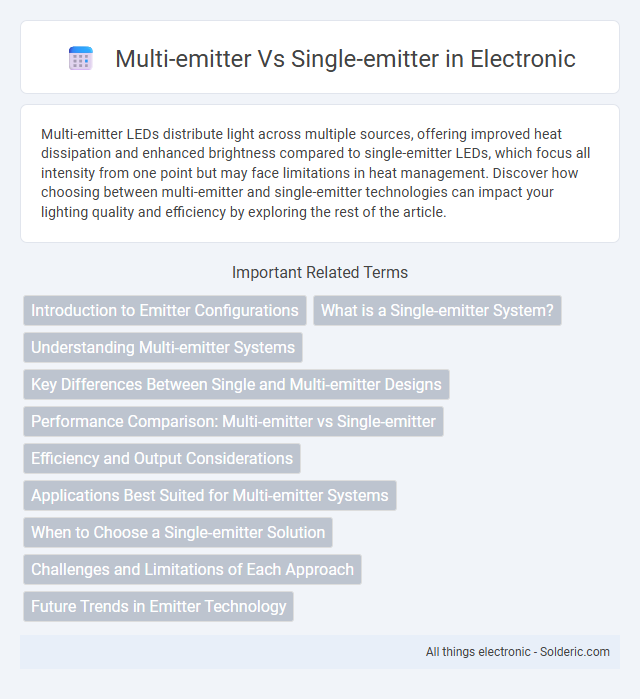Multi-emitter LEDs distribute light across multiple sources, offering improved heat dissipation and enhanced brightness compared to single-emitter LEDs, which focus all intensity from one point but may face limitations in heat management. Discover how choosing between multi-emitter and single-emitter technologies can impact your lighting quality and efficiency by exploring the rest of the article.
Comparison Table
| Feature | Multi-emitter | Single-emitter |
|---|---|---|
| Light Output | Higher brightness, multiple light sources combined | Lower brightness, single light source |
| Heat Management | Improved heat dissipation due to distributed emitters | Heat concentrated on one emitter, higher thermal stress |
| Application | Ideal for high-power lighting and wide-area illumination | Best for focused, smaller-scale lighting |
| Cost | Higher initial cost due to complexity | Lower cost and simpler design |
| Reliability | More reliable with redundancy in emitters | Single point of failure |
| Size | Larger footprint due to multiple emitters | Compact and smaller form factor |
Introduction to Emitter Configurations
Multi-emitter configurations consist of several light sources combined to increase brightness and improve heat dissipation, making them ideal for high-power LED applications. Single-emitter setups use a solitary LED chip, offering simplicity and uniform light output suitable for compact designs and precise lighting needs. Choosing between multi-emitter and single-emitter configurations depends on factors such as power requirements, thermal management, and desired luminous intensity.
What is a Single-emitter System?
A Single-emitter system uses one light source to emit photons, providing focused and precise illumination ideal for applications requiring targeted energy delivery such as laser cutting or optical communication. Compared to Multi-emitter systems, Single-emitter setups typically offer greater beam coherence and simplicity, resulting in easier calibration and alignment. Your choice depends on whether you prioritize uniform coverage with multiple lights or high-intensity, accurate output from a single emitter.
Understanding Multi-emitter Systems
Multi-emitter systems utilize multiple light sources to enhance illumination intensity, uniformity, and control compared to single-emitter configurations that rely on one concentrated light source. These systems improve thermal management by distributing heat across several emitters, leading to longer device lifespan and higher reliability. Industrial applications such as LED displays, automotive headlights, and advanced optical sensors benefit significantly from multi-emitter designs due to their flexibility and superior performance.
Key Differences Between Single and Multi-emitter Designs
Single-emitter designs utilize one light source to produce a focused, high-intensity beam with simpler thermal management, ideal for applications requiring precise illumination. Multi-emitter designs integrate multiple light sources, enabling higher overall brightness, improved heat dissipation, and greater flexibility in beam shaping for broader coverage. The key differences lie in complexity, thermal handling, and light distribution efficiency, with multi-emitter systems offering scalability and enhanced performance for diverse lighting needs.
Performance Comparison: Multi-emitter vs Single-emitter
Multi-emitter LEDs deliver higher luminous efficacy and improved heat dissipation compared to single-emitter designs, resulting in enhanced brightness and longer operational lifespan. Single-emitter LEDs often face limitations in power density and thermal management, which can reduce overall efficiency and durability. Your choice between multi-emitter and single-emitter configurations should consider performance requirements such as light output, thermal performance, and reliability for specific applications.
Efficiency and Output Considerations
Multi-emitter LEDs typically offer higher total luminous output and improved heat dissipation compared to single-emitter LEDs, enhancing overall device efficiency. The distributed light sources in multi-emitter setups minimize thermal buildup, enabling sustained high-performance operation without significant efficiency drops. Single-emitter LEDs often provide more focused light output but may suffer from greater thermal stress, limiting their efficiency at high power levels.
Applications Best Suited for Multi-emitter Systems
Multi-emitter systems excel in applications requiring high power density and precise beam shaping, such as advanced LiDAR, optical communication, and industrial laser processing. Their ability to combine multiple emitters into a single, coherent output enhances performance in environments demanding increased reliability and scalability. Your projects involving large-area coverage or complex beam patterns benefit significantly from the uniformity and adaptability of multi-emitter configurations.
When to Choose a Single-emitter Solution
Single-emitter LED solutions are ideal when precise light control and focused illumination are required, such as in automotive headlights or architectural lighting where beam shaping is critical. They offer superior thermal management and simpler driver circuitry, reducing complexity and enhancing reliability for your project. Choosing single-emitter LEDs ensures higher efficiency and better lifespan in applications demanding consistent, high-quality lighting performance.
Challenges and Limitations of Each Approach
Multi-emitter systems face challenges such as complex beamforming algorithms and increased interference management due to multiple signal sources. Single-emitter approaches have limitations in coverage and power efficiency, often requiring higher individual transmitter power to achieve the desired range. Both methods encounter trade-offs between hardware costs, spatial resolution, and signal processing complexity.
Future Trends in Emitter Technology
Future trends in emitter technology are increasingly favoring multi-emitter designs due to their higher efficiency, improved thermal management, and enhanced light distribution compared to single-emitter counterparts. Innovations in multi-emitter arrays enable better control over beam shaping and color mixing, which benefits applications in advanced lighting and optical communication systems. Your choice of emitter technology will likely shift towards multi-emitter solutions as they continue to evolve with improved performance and integration capabilities.
Multi-emitter vs Single-emitter Infographic

 solderic.com
solderic.com